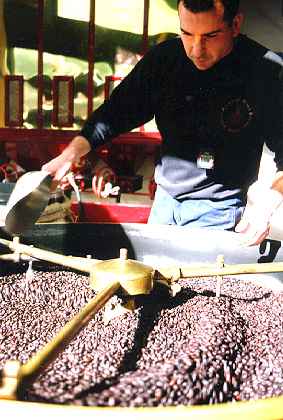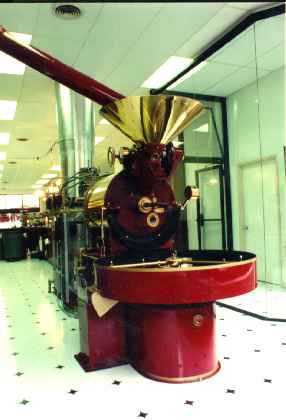Special Feature: Products Sally Recommends
Interview with a Roastmaster
Frank Gonzalez, roastmaster at San Francisco's Caffe Roma, gets to work at five-thirty in the morning.
 "The first thing I do," he says, "is down two or three double shots while we set up." Shots of espresso, that is, the better to get that coffee edge going. "Then I read the sports and business sections, and serve some coffees. I start roasting about nine-thirty."
"The first thing I do," he says, "is down two or three double shots while we set up." Shots of espresso, that is, the better to get that coffee edge going. "Then I read the sports and business sections, and serve some coffees. I start roasting about nine-thirty."
So begins a day in the life of a roastmaster, someone who is part cook, part scientist and part seer, with a dash of luck and a pinch of passion thrown in for good measure. I recently sat down with Frank over an espresso (for him) and a cappuccino (for me) to learn a bit more about the fine art of coffee roasting.
"You have to love what you do," Frank tells me. "I can't wait to start roasting in the morning."
The roasting process begins with the selection of beans to be used for the day. "We have twelve different types of beans from all over the world," Frank says. "We use mostly Central American beans, since they're the basis for a good espresso. We also use only 100 percent Arabica beans as opposed to Robusta, which aren't very good quality. Central American beans tend to be spicy as well as a harder bean, so they have less moisture. Beans from Java, on the other hand, are much softer. When we do a blend, we compensate for the moisture in the beans, so it's a combination of hard and soft beans."
Getting those beans cooked just right means preheating the roasting machine. Frank likes to get his roaster, a newish German Probat model, nice and hot, so he cranks it up about half an hour before he starts the roasting process. Roasting machines come in several varieties, most commonly wood, natural gas or air roasters. The Probat at Roma is a natural gas roaster. "You tend to get the most even roast with an air machine," according to Frank. "You can get hot spots in a natural gas roaster, so you have to be more careful with what you do."
Next up is the blending process. Some of the roasts at Roma are varietals, meaning one type of bean is being roasted at a time. Many, however, are blends, a combination of beans which are brought together to achieve a unique flavor and bite. Here is where the roastmaster turns alchemist.
"You've got to play with your blends," Frank tells me. "That's how you get the best out of them. It took Tony (Azzollini, his partner) a year to perfect the espresso roast, and it took me another month to get his technique down pat. It's a matter of consistency." Once a blend is selected, Frank punches it into a computerized panel, which sends the beans sailing into the feed hopper, the cone-shaped apparatus at the top of the roasting machine. From there, they are loaded into the large drum portion of the machine, and the actual roasting begins.
"We time each roast," Frank continues. "The 'sampler' (a long, thin scoop which rests largely inside the machine) allows you to check the coffee. Our Roma Blend, which is a medium roast, takes about 13 1/2-14 minutes. It's 16 1/2 minutes for a dark roast."
The beans themselves undergo an interesting morphing process as they roast. They pop, much like popcorn. The first pop is at 7 1/2 minutes. The beans cook inside out first, then outside in. Once the moisture has left the bean, you begin to cook the coffee in earnest. The second pop comes after 12 1/2 minutes. Then things get tricky, or at least interesting.
"You have to be aware of the temperature of the machine," says Frank. "I have to adjust the burners (there are three) to compensate for additional heat in the machine. Coffee caramelizes at 270 degrees, so I have to keep the machine at 255 to 260." Sight and smell are the key indicators that the coffee is ready. "Once the coffee is ready, I have maybe thirty seconds to fine-tune the roast. On a dark roast, since it cooks longer, I have maybe ten seconds to get it just right. Coffee cooks so fast! I try to bring out a little oil on the bean, that nice sheen which looks like sweat. It makes a difference."
Once the beans are ready, they are released into the cooling tray, where they'll cook a little longer. They are then dispatched to large vats where they await their final destination, be it the cafe, someone's home or a restaurant kitchen.
 A number of the roasts at Roma are dark roasts. Their Sicilian Gold (great name!) is the darkest, and ideal for drip coffee. Generally medium to dark roasts are used for espresso. "When you sprinkle sugar in a good espresso, it should sit on top of the espresso for three seconds," says Frank. "Then you know it's a good one." You'll also get less caffeine in an espresso than you will in brewed coffee. "Espresso is the extract, the richest part of coffee," Frank continues. "With regular coffee you're getting a bigger dose of coffee and caffeine. A slow drip also pulls more caffeine. And there's more caffeine in a lighter roast than a darker one, which is contrary to what most people think."
A number of the roasts at Roma are dark roasts. Their Sicilian Gold (great name!) is the darkest, and ideal for drip coffee. Generally medium to dark roasts are used for espresso. "When you sprinkle sugar in a good espresso, it should sit on top of the espresso for three seconds," says Frank. "Then you know it's a good one." You'll also get less caffeine in an espresso than you will in brewed coffee. "Espresso is the extract, the richest part of coffee," Frank continues. "With regular coffee you're getting a bigger dose of coffee and caffeine. A slow drip also pulls more caffeine. And there's more caffeine in a lighter roast than a darker one, which is contrary to what most people think."
While Frank has been roasting at Caffe Roma for nearly seven years, the cafe has been around for twenty. The roasting tradition goes back even further, as members of the Azzollini clan have been roasting in Bari, Italy for generations. Today the cafe and roasting operation are in the capable hands of the youngest generation, consisting of brother Tony, sisters Lisa and Irene, and Irene's boyfriend Frank. Each member of this hardworking group knows that teamwork is the key, along with a passion for what you do. Frank sums it up best.
"You get real satisfaction from putting out a product that folks consume and enjoy. Italians come in here and tell me 'this is the best coffee I've had in the U.S.' That feels great. I come to work to roast coffee and to do it the best I can. Roasting is a love."
Thanks to Frank, you can taste that love in every cup.
Caffe Roma is located at 526 Columbus Avenue in San Francisco's North Beach district. (415) 296-7662 (ROMA) or (800) 296-7662 (ROMA). They ship (both wholesale and retail) around the world.
Note: This information was accurate when it was published. Please be sure to confirm all rates and details directly with the businesses in question before making your plans.



